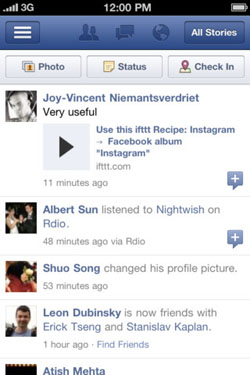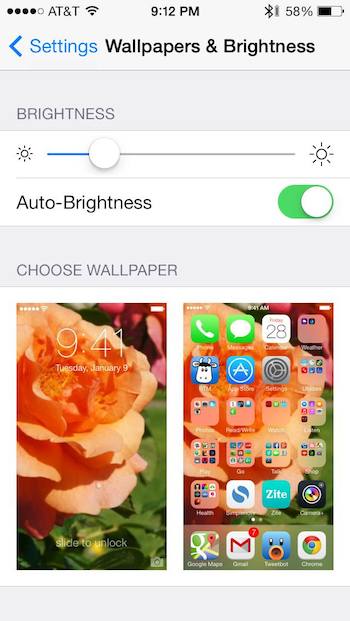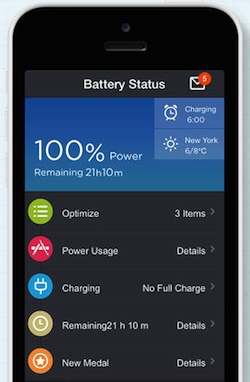If you own an iPhone, there’s a good chance you run into battery problems now and again — times you wish you had the battery life to take one more photo, look up the location of a restaurant or make a quick phone call. But the more we use and rely on our smartphones, the more likely they are to run out of juice when we need them most.
With a bit of awareness about how you use your iPhone and what apps you’re using on it, you can curb your iPhone’s battery-draining tendencies. We’ll take a look at what types of apps commonly drain battery power and look into ways to keep your iPhone juiced up.
What’s always running?

The biggest battery drain by far are the apps you’re always using. Do you keep Facebook open on your iPhone and check it regularly? Do you have AOL Instant Messenger (AIM) open on your phone to talk to friends on the go, or Pandora streaming music in the background? Some of these apps keep running in the background, burning battery life even when you aren’t paying any attention to them.
Looking at our examples, Facebook actively notifies you of new updates or messages, AIM constantly checks to see if your friends are on or offline, and streaming apps like Netflix, Hulu, Pandora and Spotify keep streaming until you tell them to stop. As long as these apps are active and doing things, they’re burning through your battery life.
You also need to be wary of apps that keep your screen active (because although you might not think about it, it takes a lot of energy to keep your phone’s screen lit up) or put a strain on your smartphone’s internal processor. Beyond the video streaming apps we’ve already mentioned, be on the watch for games; they might be fun, but they’ll cut sharply into your battery life. Video and photo editing apps like iMovie and iPhoto also take a lot of power to run, so keep them closed unless you need them. And using your phone as a flashlight is useful, but keeping the screen or camera flash active can definitely ruin your battery expectations.
Shutting down the battery drainers
If you’re concerned about your iPhone’s battery life (or you’re going over your phone’s data plan limits), it’s worth spending a few minutes to think about what you really need your phone to be doing. If there’s anything you keep running but don’t actually need, the best bet is to close it. Log out of AIM, skip checking Facebook and close Pandora when you’re done listening.
Closing apps isn’t as straightforward as you’d think. Just pressing your iPhone’s home button to go back to the main screen may seem to close an app, but it will still be running in the background. To completely close an app when you’re done using it, follow these simple steps:
Keep location services on lockdown

Location services can be terribly convenient, letting apps know where you are and providing useful, location-specific information. However, keeping your iPhone’s GPS running can go through your remaining battery power very quickly.
You can tell when something on your phone is using location services by the arrow icon that appears in your menu bar at the top of the screen. If you’d like to save battery life, you have several options where location services are concerned.
Close apps that use location services when you don’t need them. Common culprits are map and navigation apps and services that provide you with location-based information, like Yelp and Foursquare.
If you don’t think an app needs access to location services, it’s easy to disable it on an app-by-app basis. Just open Settings > Privacy > Location Services, and find the apps you don’t want to access location data. Move the slider next to them to the off position. That application won’t be able to fire up your phone’s GPS until you change that setting.
You can also disable location services entirely if you aren’t using them. Go to Settings > Privacy > Location Services, and move the slider by Location Services to the off position.
Watch what you download
Downloading lots of data doesn’t just burn through your monthly data plan; it also burns through your battery life as your phone works to pull that data down from cellular or Wi-Fi networks. So if you’re particularly concerned about battery life, you probably want to avoid apps that will be a major data drain.
The most common culprits are anything that streams video or music: Netflix, Hulu, HBO Go, YouTube, Pandora, Spotify, Google+ Hangouts, Skype and FaceTime. You might not think of your email, which pushes new messages to your phone, or your favorite social networks, where you’re viewing friends’ photos, videos and status updates (and probably uploading your own!). Though text-based updates are small, photos and videos are larger files (especially as the iPhone’s camera improves), and viewing lots of them will leave you with less battery life.
So when you’re on a battery budget, set your phone to fetch your email at an interval instead of having it constantly pushed to your phone. For your social networks, skip uploading photos and videos or viewing those of your friends. You’re best off avoiding apps like Facebook, Instagram, Flickr, 500px, Tumblr and Pinterest and even browsing image-intensive websites. (If you’re wondering why Twitter didn’t make the list, it’s because Twitter only loads text and a small preview photo unless you click to open it.)
Be careful of free apps
Though free apps may seem tempting, these ad-supported apps burn at least a little extra battery power to download and display advertisements. In our own experience, apps downloading advertisements was the fourth highest data use on our iPhone — and as we mentioned above, when you’re downloading data, you’re also burning down your battery.
If you like an app enough to use it all the time, why not go ahead and pay a dollar or two to buy it instead of making your phone download advertisements every time you open it?
Our best battery tips

There are lots of things your phone can do that will cause your battery to drain faster — and you might not even use some of them. Here are some common battery culprits and how to disable them if and when you don’t need them.
Disable Bluetooth
If you don’t use any Bluetooth accessories, turn Bluetooth off under Settings > Bluetooth. In iOS 7, there’s a shortcut: Swipe up from your home screen to bring up a mini settings menu, and click the Bluetooth icon to shut off Bluetooth.
Reduce screen brightness
Keeping your screen brightly lit at all times can be a massive battery drain. Go to Settings > Wallpapers & Brightness (or Brightness & Wallpaper on older versions of iOS), and set the brightness slider to the lowest level you’re comfortable with. Then enable Auto-Brightness, which automatically makes the screen darker or lighter in response to current lighting conditions. You can and should also reduce screen drain by setting your phone’s screen lock to kick on as quickly as possible, reducing the amount of time the screen is needlessly lit. Go to Settings > General > Auto-Lock, and set it to 1 minute.
Turn off notifications
It’s handy to get notifications when an app wants to tell you something, but it also means that your iPhone is always keeping track of what the app is up to, which burns battery power. Even worse, a lock screen notification that pops up lights up your screen for a minute to show it to you — and as we noted above, keeping the screen lit can be a significant battery drain.
Turn off notifications for individual apps under Settings > Notification Center (or Notifications for older versions of iOS). Most apps seem happy to notify you about any and everything, so we suggest disabling most of these notifications. Scroll down to the list of apps, and click each app to see what kind of notifications it does. If you don’t want any, select None and turn off Badge App Icon, Alert Sound, Show in Notification Center and Show on Lock Screen (or View in Lock Screen on older versions of iOS).
Disable Wi-Fi
If you aren’t using Wi-Fi, turn it off; otherwise, your phone will constantly check for available Wi-Fi networks, draining your battery in the process. You can disable Wi-Fi under Settings > Wi-Fi, but don’t forget to turn it back on again when you need it or you’ll regret all that data use when you see your next wireless bill!
If you don’t need any kind of data service (or if you’re in an area where you aren’t getting a good signal), you can save a lot of battery life by turning on Airplane Mode under Settings. This disables Bluetooth, Wi-Fi and cellular service, cutting off all of the worst battery drainers. Again, iOS 7 has a shortcut: Swipe up from your home screen and click the Wi-Fi icon to disable Wi-Fi or the Airplane Mode icon to enable Airplane Mode.
Check your email less frequently
Many of us use our phones to keep tabs on our email accounts, but how often you check your email can take a major toll on your battery life. The iPhone lets you set up new mail to be automatically pushed to your phone (although not all email services support this) or fetched from the mail server at certain intervals.
Because push mail means a constant connection, you’ll get better battery life by fetching mail at intervals — and the less frequent the interval, the better your battery life. To change how often your phone checks your email, go to Settings > Mail, Contacts, Calendars > Fetch New Data. For best battery life, turn Push off and reduce your Fetch interval or set it to Manual. If you really need mail from a specific account fast, you can also enable Push-only on the accounts you choose from this menu.
Keep charged!
Instead of waiting for your battery to run dry, plug it in when you’re at your desk at work or in the car. Even a few minutes worth of charging could make the difference.
There’s an app for that!

Many apps claim to help improve your battery life. While none of them work miracles, they can all help you make the most of your battery and stay aware of how much battery life you have left. Here are our favorites.
Battery Saver
This free app isn’t very intuitively organized and has some oddball extras (like the ability to check the weather and set alarms, ostensibly for charging your phone), but since it offers more battery information than the competition, we’re willing to overlook these oddities.
The app tells you how much battery life you have remaining in time, listing how long your battery will last on various tasks (click Remaining), which is very useful for determining what your 50% battery life will get you. Its most useful feature is the ability to tell you how much power different apps are draining (click App Being Used), so you know which apps you should shut down. Click Optimize to find out how much extra battery life you can get by changing certain system settings.
Price: Free on iTunes
Onavo Count
This one is the only iPhone app that tells you how much data each of your apps is using. Before you click to download it, be aware what it doesn’t do: Onava Count is poor at measuring whether you’re about to go over your cellular plan’s data cap. In our experience, the app doesn’t differentiate between cellular and Wi-Fi data. But Onavo does do a great job of telling you which apps are spending a lot of time downloading — and those are the apps you might want to see about shutting down when you need to save battery life.
Price: Free on iTunes
DataMan Next
If you’re looking for an app to help you stay inside your data limits, we like the easy-to-use DataMan Next. However, you may also find the iPhone’s built-in monitoring works just as well for you; you can find it under Settings > General > Usage > Cellular Usage, though you’ll have to remember to reset it manually every month.
Price: $1.99 on iTunes
Am I overdoing it on data?
As we’ve said, downloading data can kill your battery life — and even worse, if you go over your cell phone plan’s data caps, you can get slapped with extra fees. Fortunately, each carrier offers easy options to check how much data you’ve used. If you don’t want to hit the web to look up your account information, you can check the details from your phone.
Now that you’re armed with information, we wish you good luck and long life with your iPhone battery!
This article was written by Elizabeth Harper and originally appeared on Techlicious.
More from Techlicious:
More Must-Reads From TIME
- The 100 Most Influential People of 2024
- The Revolution of Yulia Navalnaya
- 6 Compliments That Land Every Time
- What's the Deal With the Bitcoin Halving?
- If You're Dating Right Now , You're Brave: Column
- The AI That Could Heal a Divided Internet
- Fallout Is a Brilliant Model for the Future of Video Game Adaptations
- Want Weekly Recs on What to Watch, Read, and More? Sign Up for Worth Your Time
Contact us at letters@time.com